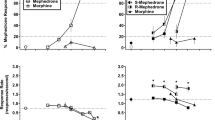Abstract
Rationale
Serotonergic hallucinogens such as (+)-lysergic acid diethylamide (LSD) and dimethyltryptamine (DMT) produce distinctive visual effects, whereas the synthetic hallucinogen N,N-diisopropyltryptamine (DiPT) is known for its production of auditory distortions.
Objective
This study compares the discriminative stimulus effects of DiPT to those of visual hallucinogens.
Methods
Adult male rats were trained to discriminate DiPT (5 mg/kg, 15 min) from saline under a FR10 schedule. A dose–effect and time course of DiPT's discriminative stimulus effects were established. DMT, (−)-2,5-dimethoxy-4-methylamphetamine (DOM), LSD, (±)-methylenedioxymethamphetamine (MDMA), and (+)-methamphetamine were tested for cross-substitution in DiPT-trained animals.
Results
Rats learned to discriminate DiPT from saline in an average of 60 training sessions (30 drug and 30 saline). DiPT (0.5–5 mg/kg) produced dose-dependent increases in drug-appropriate responding (DAR) to 99 % (ED50 = 2.47 mg/kg). Onset of the discriminative stimulus effects was within 5 min, and the effects dissipated within 4 h. Full substitution for the discriminative stimulus effects of DiPT occurred with LSD, DOM, and MDMA. DMT only partially substituted for DiPT (65 % DAR), whereas (+)-methamphetamine failed to substitute for DiPT (29 % DAR).
Conclusions
The discriminative stimulus effects of DiPT were similar those of a number of synthetic hallucinogens, only partially similar to those of DMT, but not similar to (+)-methamphetamine. The putative DiPT-induced auditory distortions do not lead to discriminative stimulus effects distinguishable from other hallucinogens.



Similar content being viewed by others
References
Appel JB, West WB, Rolandi WG, Alici T, Pechersky K (1999) Increasing the selectivity of drug discrimination procedures. Pharmacol Biochem Behav 64:353–358
Buckholtz NS, Boggan WO (1977) Monoamine oxidase inhibition in brain and liver produced by beta-carbolines: structure–activity relationships and substrate specificity. Biochem Pharmacol 26:1991–1996
Cozzi NV, Gopalakrishnan A, Anderson LL, Feih JT, Shulgin AT, Daley PF, Ruoho AE (2009) Dimethyltryptamine and other hallucinogenic tryptamines exhibit substrate behavior at the serotonin uptake transporter and the vesicle monoamine transporter. J Neural Transm 116:1591–1599
Gatch MB, Rutledge MA, Carbonaro T, Forster MJ (2009) Comparison of the discriminative stimulus effects of dimethyltryptamine with different classes of psychoactive compounds in rats. Psychopharmacology 204:715–724
Gatch MB, Forster MJ, Janowsky A, Eshleman AJ (2011) Abuse liability profile of three substituted tryptamines. J Pharmacol Exp Ther 338:280–289
Glennon RA (1986) Discriminative stimulus properties of phenylisopropylamine derivatives. Drug Alcohol Depend 17:119–134
Glennon RA (1988) Site-selective serotonin agonists as discriminative stimuli. Psychopharmacol Ser 4:15–31
Glennon RA (1999) Arylalkylamine drugs of abuse: an overview of drug discrimination studies. Pharmacol Biochem Behav 64:251–256
Glennon RA, Young R, Jacyno JM, Slusher M, Rosecrans JA (1983) DOM-stimulus generalization to LSD and other hallucinogenic indolealkylamines. Eur J Pharmacol 86:453–459
Helsley S, Fiorella D, Rabin RA, Winter JC (1998) A comparison of N, N-dimethyltryptamine, harmaline, and selected congeners in rats trained with LSD as a discriminative stimulus. Prog Neuropsychopharmacol Biol Psychiatry 22:649–663
Jarbe TU (1980) LSD-25 as a discriminative stimulus for response selection by pigeons. Pharmacol Biochem Behav 13:549–554
Nagai F, Nonaka R, Satoh K, Kamimura H (2007) The effects of non-medically used psychoactive drugs on monoamine neurotransmission in rat brain. Eur J Pharmacol 559:132–137
National Research Council (2003) Guidelines for the Care and Use of Mammals in Neuroscience and Behavioral Research. The National Academies, Washington (DC)
Nichols DE (2004) Hallucinogens. Pharmacol Ther 101:131–181
Pierce PA, Peroutka SJ (1989) Hallucinogenic drug interactions with neurotransmitter receptor binding sites in human cortex. Psychopharmacology 97:118–122
Shulgin AT, Carter MF (1980) N, N-Diisopropyltryptamine (DIPT) and 5-methoxy-N, N-diisopropyltryptamine (5-MeO-DIPT). Two orally active tryptamine analogs with CNS activity. Commun Psychopharmacol 4:363–369
Shulgin AT, Shulgin A (1997) TiHKAL: The continuation. Transform, Berkeley
Strassman RJ, Qualls CR, Berg LM (1996) Differential tolerance to biological and subjective effects of four closely spaced doses of N, N-dimethyltryptamine in humans. Biol Psychiatry 39:784–795
Titeler M, Lyon RA, Glennon RA (1988) Radioligand binding evidence implicates the brain 5-HT2 receptor as a site of action for LSD and phenylisopropylamine hallucinogens. Psychopharmacology 94:213–216
Winter JC (2009) Hallucinogens as discriminative stimuli in animals: LSD, phenethylamines, and tryptamines. Psychopharmacology 203:251–263
Acknowledgments
Funding was provided by the Addiction Treatment Discovery Program of the National Institute on Drug Abuse (NIH N01DA-7-8872) and by T32 AG020494.
Conflict of interest
There are no conflicts of interest.
Author information
Authors and Affiliations
Corresponding author
Rights and permissions
About this article
Cite this article
Carbonaro, T.M., Forster, M.J. & Gatch, M.B. Discriminative stimulus effects of N,N-diisopropyltryptamine. Psychopharmacology 226, 241–246 (2013). https://doi.org/10.1007/s00213-012-2891-x
Received:
Accepted:
Published:
Issue Date:
DOI: https://doi.org/10.1007/s00213-012-2891-x




